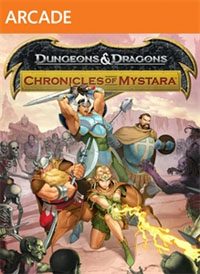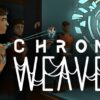A few months ago, I reviewed Darkstalkers Resurrection, another Iron Galaxy Studios/Capcom remake of a couple 1990s classics, and I’m happy to report that Dungeons & Dragons: Chronicles of Mystara is as excellent of an arcade-to-console port, if not better.
Chronicles packages together Capcom’s two Dungeons & Dragons-based side-scrolling brawlers, Tower of Doom (1993) and its sequel, Shadow Over Mystara (1996). The games’ format is similar to that of other arcade beat ‘em ups from that era—like Streets of Rage, Final Fight, Golden Axe, or Guardians of the ‘Hood—and is almost guaranteed to bring childhood nostalgia welling up in the hearts of gamers around my age. Both Tower of Doom and Shadow Over Mystara are high-quality examples of the genre with an endearing touch of D&D. You even name your chosen hero, who hoovers up loot, levels up, and grows stronger depending on monsters defeated during the course of each level.

Up to four players, either local or online, can play cooperatively, and the saying “the more the merrier” definitely holds true in these games. Tower of Doom and Shadow Over Mystara are both great fun to play with family or friends, and while you can continue as many times as you like, without penalty, if you die, the arcade style of the game allows players to cycle upon death without interrupting gameplay for the other players. They’re also relatively kid-friendly, if you’re all right with cartoon violence and bandeau bikini tops.
As far as characters go, Tower of Doom offers players a choice among the Cleric, Dwarf, Elf, and Fighter, and Shadow Over Mystara adds the Magic-User and Thief, each with two costume choices. Each class plays a bit differently and is surprisingly well balanced with the others. For instance, the Cleric’s a bit ponderous to move about but can fling spells between bashing in skulls with his mace, and the ninja-like Thief is spry and can double-jump to fly across the battlefield but inflicts less damage than the heavier fighters.
Both games use a fairly simple, intuitive, and customizable control scheme with only four basic commands, one button each for attack, jump, secondary attack, and cycling through and selecting a secondary attack. Your character’s secondary attack choices depend on his or her class and items picked up or purchased during the game, such as one-shot spell scrolls, thrown weapons, or magic items. Characters can also block, crouch, slide, or pull off character-specific combos or special abilities, similar to (but simpler than) typical fighting game controls.

Despite their D&D roots, the games play like true beat ‘em ups and with little ado, plopping players into chaotic melee after melee with beautifully rendered monsters and humongous bosses. In between, you’ll crack open chests, collect as much loot as you can carry, and dodge booby traps, but for the most part, it’s straight-up action up until the end. A single run of either game takes only about one to two hours, but one feature I really like about both games is that they’re somewhat randomized and have several branches where players can choose to travel to different locations. This, along with the variety of characters, allows for significant replay.
As arcade games, these titles were definitely quarter guzzlers. In fact, they’re challenging enough that I’m not sure it’s even possible to get through some boss fights without dying horribly over and over again. The console port gives you infinite continues and may make healing feel pointless or take the bite out of the challenge for some players, but for gamers like me who find the financial risk of arcade games more annoying than motivating, it’s wonderful to be able to enjoy these games without that pressure.
Like Darkstalkers Resurrection, Chronicles of Mystara also throws in a bunch of additional achievements, challenges, and unlockable bonus material (e.g., concept art) buyable with points earned during gameplay as an incentive to continue replaying the games. Interestingly, you can unlock house rules—such as allowing characters to recover health when striking enemies or causing the game to spawn more treasure—to further customize the game experience to your liking.

Overall, Chronicles is a very good port of two very good arcade games. All menus are very clear, aesthetically pleasing, and easy to navigate; the port adds a number of ways that you can customize how the game looks, sounds, and plays; both online and local multiplayer play are supported; and you can conveniently switch between Tower of Doom and Shadow Over Mystara with the press of a button. The game graphics look great in all three modes (no filter, crisp, or smooth), and the audio is clean.
The only feature that seems to be missing is an easy way to share screenshots or videos of the game over social media, like the YouTube feature included with Darkstalkers Resurrection. While it’s not a deal breaker by any means, I think it could have been a nice addition. As a games reviewer and someone who frequently writes and talks about games in general, I would certainly make use of a feature to share screenshots of games online, especially with older and less well known gems like this one.
I think I hardly need to say that picking up Chronicles of Mystara is a no-brainer for those of us who have fond memories of playing games like this in the arcade and for those gamers looking for a taste of the 1990’s side-scrolling brawler genre. At 1200 Microsoft Points ($15.00 USD), it’s not the least I’ve ever paid for a couple of older games, but it won’t break the bank, and the replay value, multiplayer capability, and port quality are worth the price.

















